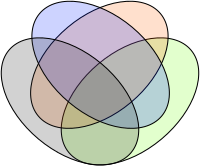
Photo from wikipedia
Given equidimensional (generalized) cycles $$\mu _1$$ μ 1 and $$\mu _2$$ μ 2 on a complex manifold Y we introduce a product $$\mu _1\diamond _{Y} \mu _2$$ μ 1 ⋄… Click to show full abstract
Given equidimensional (generalized) cycles $$\mu _1$$ μ 1 and $$\mu _2$$ μ 2 on a complex manifold Y we introduce a product $$\mu _1\diamond _{Y} \mu _2$$ μ 1 ⋄ Y μ 2 that is a generalized cycle whose multiplicities at each point are the local intersection numbers at the point. If Y is projective, then given a very ample line bundle $$L\rightarrow Y$$ L → Y we define a product $$\mu _1{\bullet _L}\mu _2$$ μ 1 ∙ L μ 2 whose multiplicities at each point also coincide with the local intersection numbers. In addition, provided that $$\mu _1$$ μ 1 and $$\mu _2$$ μ 2 are effective, this product satisfies a Bézout inequality. If $$i:Y\rightarrow {\mathbb P}^N$$ i : Y → P N is an embedding such that $$i^*\mathcal O(1)=L$$ i ∗ O ( 1 ) = L , then $$\mu _1{\bullet _L}\mu _2$$ μ 1 ∙ L μ 2 can be expressed as a mean value of Stückrad–Vogel cycles on $${\mathbb P}^N$$ P N . There are quite explicit relations between $${\diamond }_Y$$ ⋄ Y and $${\bullet _L}$$ ∙ L .
Journal Title: Mathematische Zeitschrift
Year Published: 2021
Link to full text (if available)
Share on Social Media: Sign Up to like & get
recommendations!